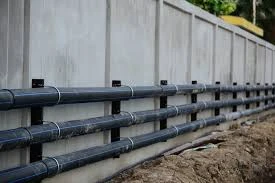Hyd . 17, 2024 18:34 Back to list
PVC Irrigation Pipe Connectors and Fittings for Efficient Water Management Systems
Understanding PVC Irrigation Pipe Fittings A Comprehensive Guide
In the realm of modern agriculture and gardening, efficient irrigation is paramount. One of the most versatile and commonly used materials for irrigation systems is PVC (Polyvinyl Chloride). PVC irrigation pipe fittings are essential components that facilitate the seamless connection and functionality of irrigation networks. This article delves into the importance, types, advantages, and installation of PVC irrigation pipe fittings, providing a comprehensive understanding of their role in effective water management.
Importance of PVC Irrigation Pipe Fittings
PVC irrigation pipe fittings serve as connectors or joints in an irrigation system, enabling the seamless flow of water from one section to another. They are critical for ensuring that the system operates effectively, delivering water evenly to crops or gardens. Without appropriate fittings, an irrigation system may suffer leaks or pressure drops, leading to inefficient water use and potential crop stress.
In addition to functionality, the quality of fittings impacts the longevity of the irrigation system. Well-made PVC fittings resist corrosion, UV degradation, and chemical exposure, ensuring that they maintain their integrity in various environmental conditions.
Types of PVC Irrigation Pipe Fittings
Understanding the different types of PVC irrigation fittings is essential for selecting the right components for your specific needs. Here are some of the most common types
1. Elbows These fittings make sharp turns in the irrigation line. Available in various angles, such as 90-degree and 45-degree models, elbows help navigate obstacles and direct water flow efficiently.
2. Tees Used to create a branch in the pipeline, tees connect three sections of pipe at a right angle. They are useful for splitting the flow of water to different areas of a field or garden.
3. Adapters These fittings allow connection between different types or sizes of pipes. Adapters are crucial when integrating PVC pipes with other materials, such as metal or poly tubing.
4. Caps and Plugs Caps securely close the end of a pipe, while plugs are used to stop the flow in a section of the irrigation system. They are essential for maintenance and system modifications.
5. Couplings Couplings join two lengths of pipe together, allowing for easy extension or repair of existing systems. Standard and slip couplings are commonly used to connect pipes of the same diameter.
6. Flanges Flanged fittings are used to connect pipes for a more secure and leak-proof joint, ideal for larger systems where disassembly may be necessary.
7. Valves Control valves are key components that regulate water flow within the irrigation system. They enable the operator to turn water on and off or adjust flow rates as needed.
Advantages of PVC Irrigation Pipe Fittings
pvc irrigation pipe fittings

Using PVC for irrigation fittings comes with numerous advantages
- Durability PVC is resistant to corrosion, rust, and chemical damage, which translates to a longer lifespan compared to metal fittings.
- Lightweight PVC fittings are significantly lighter than metal options, making them easier to handle and install.
- Cost-Effectiveness Generally, PVC fittings are more affordable than alternatives, leading to reduced overall installation costs for irrigation systems.
- Versatility PVC fittings can accommodate various irrigation designs, suitable for everything from small garden systems to large-scale agricultural installations.
- Ease of Installation The installation process for PVC fittings involves simple cutting and gluing, which can often be done without specialized tools.
Installation Considerations
When installing PVC irrigation pipe fittings, several considerations must be taken into account
1. Correct Sizing Ensure that all fittings match the pipe size and type. Proper sizing prevents leaks and maintains flow efficiency.
2. Use of Primer and Cement For a secure bond, it’s essential to use PVC primer and cement during assembly. This combination ensures a watertight seal that reduces the risk of leaks.
3. Pressure Testing After installation, conducting a pressure test is crucial to identify any potential leaks in the system before it is put into operation.
4. Regular Maintenance Inspecting fittings regularly for signs of wear or damage will help prevent costly repairs and ensure the continued efficiency of the irrigation system.
Conclusion
PVC irrigation pipe fittings are key components in the infrastructure of efficient irrigation systems. Understanding their types, advantages, and installation processes can significantly enhance water management strategies in agriculture and gardening. By selecting the right fittings and ensuring proper installation, one can create a robust irrigation system that supports healthy plant growth and sustainable water use.
-
High Transparency PVC Clear Sheet Super Transparency PVC Sheets & HDPE Cutting Board Supplier
NewsJul.04,2025
-
High-Quality PVC-M Pipe Supplier Trusted PVC Pipe Company & 75mm PVC Connection Pipe Solutions
NewsJul.04,2025
-
PVC Transparent Sheet Roll - Durable & Flexible PVC Plastic Sheet Roll for Industrial & Home Use
NewsJun.24,2025
-
High-Quality PVC PPR Pipes and Fittings Durable ERA PPR Solutions
NewsJun.10,2025
-
High-Quality Large HDPE Sheets & Large Diameter PVC Pipe Durable Large PVC Pipe Supplier
NewsJun.10,2025
-
High Density Polyethylene Cutting Board - Durable & Food Safe
NewsJun.09,2025

